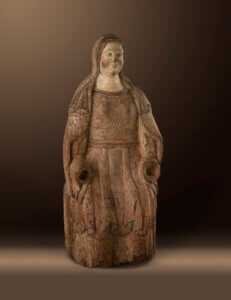This depiction of the Madonna is a masterful, early figure in a magnificent state of preservation. The Madonna corresponds to the Sedes Sapientiae type: Mary as the throne of divine wisdom. She sits on a rounded throne chair in a block-like frontal position and with an open posture. The figure is symmetrical in its execution; the meticulous frontality clearly shows the early date of origin of this impressive depiction. Her face is sculpturally and expressively carved, with high eyebrows, large and wide-open eyes and deeply notched upper eyelids. The empathetic expression is emphasized by the prominent nose, which merges seamlessly into the sharp-edged ridges of the eyebrows. Maria’s full lips are curved upwards and reveal slight dimples. The ruddy cheeks convey an impression of liveliness, emphasizing Mary’s mediating role as she communicates directly with the viewer.
The carefully crafted surfaces suggest drapery in flat relief, as is typical of the early 13th century. Mary’s veil is draped smoothly over her head and flows down over her shoulders to her upper arms. There, the hems billow out in an almost ornamental triangular style. While her robe falls straight down her upper body, it rests in a similarly doughy and geometrically designed shape below her knees. The strong symmetry in the composition reinforces the ornamental expression of the fabric – even without painted or carved surface ornamentation! – and creates a fascinating counterpoint to the otherwise flat garment sections. This gives her clothing a luxurious expressiveness and seems to resemble a brocade fabric with a dense border.
Traces of polychromy have been preserved on the fold ridges and notched grooves, indicating that the Madonna’s upper garment was painted red, the inside blue and the lower garment green. These colors are highly symbolic: from the 12th century onwards, the divine blue associated with heaven was considered the color of chastity and therefore particularly the color of Mary, who from this time onwards often wore a blue cloak over a red dress. The red is an expression of the symbolism of power, which was adopted from late antiquity. It is also often seen as the color of martyrdom. The green here could symbolize love and hope.
Literature:
Ilene H. Forsyth, The Throne of Wisdom: Wood Sculptures of the Madonna in Romanesque France, Princeton 1972.












